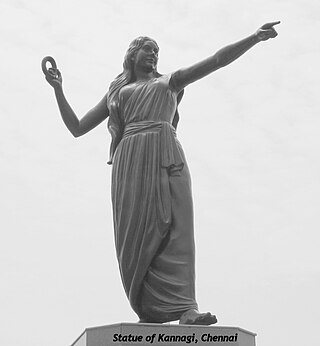
Kannagi, sometimes spelled Kannaki, is a legendary Tamil woman who forms the central character of the Tamil epic Cilappatikāram. Kannagi is described as a chaste woman who stays with her husband despite his adultery, their attempt to rebuild their marriage after her unrepentant husband had lost everything, how he is framed then punished without the due checks and processes of justice. Kannagi proves and protests the injustice, then curses the king and city of Madurai, leading to the death of the unjust Pandyan king of Madurai, who had wrongfully put her husband Kovalan to death. The society that made her suffer then endures retribution as the city Madurai, in consequence, is burnt to the ground because of her curse.
Cilappatikāram, also referred to as Silappathikaram or Silappatikaram, is the earliest Tamil epic. It is a poem of 5,730 lines in almost entirely akaval (aciriyam) meter. The epic is a tragic love story of an ordinary couple, Kaṇṇaki and her husband Kōvalaṉ. The Cilappatikāram has more ancient roots in the Tamil bardic tradition, as Kannaki and other characters of the story are mentioned or alluded to in the Sangam literature such as in the Naṟṟiṇai and later texts such as the Kovalam Katai. It is attributed to a prince-turned-monk Iḷaṅkō Aṭikaḷ, and was probably composed in the 2nd century CE.

Mudiyettu is a traditional ritual theatre and folk dance drama from Kerala that enacts the mythological tale of a battle between the goddess Kali and the demon Darika. The ritual is a part of the bhagavathi or bhadrakali cult. The dance is performed in bhadrakali temples, the temples of the Mother Goddess, between February and May after the harvesting season.

Thirumandhamkunnu Temple is a historically significant Hindu temple in Angadipuram, which was the capital of Valluvanad Rajavamsham, in Malappuram district, Kerala state, South India. The temple deity, Thirumandhamkunnil amma, was the paradevatha of the kings of Valluvanad, the local feudal kings ruled the area in the Middle Ages. The Nair warriors of Valluvanad king set out from this temple to Thirunavaya, to participate in the famous Mamankam festival. A memorial structure called the chaver thara can be found in front of the main entrance of the Thirumanthamkunnu Temple.

Sarkaradevi Temple is one of the most important temples in South India. It is situated Chirayinkeezhu town in Thiruvananthapuram district. Tradition accords a remote antiquity to this temple. Its main deity is Bhadrakali. The Sarkaradevi Temple assumed a significant status for many reasons and rose to historical importance mainly with the introduction of the famous Kaliyoot festival by Anizham Thirunal Marthanda Varma, the Travancore sovereign, in 1748. The Sarkaradevi Temple have some basic attachment with Nakramcode Devi Temple which located in Avanavanchery, Attingal.

Kanniyar Kali is a folk dance ritual performed in Temples of villages in Alathur and Chittur Taluk of Palakkad district of Kerala. The event is usually a part of Vishu celebrations of the village and usually succeeds the Vela and is usually performed during the months of April and May. It is an agricultural festival dance of Nair community. Kanniyar Kali, despite the name of the Virgin, does not have anything to do with the Kannaki cult.
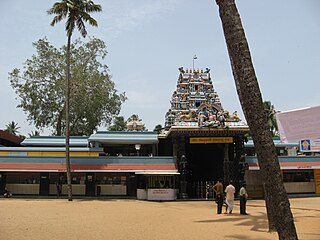
The Attukal Bhagavathy Temple is a Hindu shrine located at Attukal in Kerala, India. It is situated near the heart of the city, two kilometres away from the Padmanabhaswamy Temple, East Fort, in Thiruvananthapuram. The goddess of the temple is identified with Bhadrakali, mounted over a vetala. She is also identified with Kannagi, the heroine of Ilango Adigal's epic Cilappatikaram.

Madayikavu (Māḍāyik्kavu), also known as Thiruvarkadu Bhagavathi Temple, is a significant ancient Kaula Shakti shrine in Kerala, located near Pazhayangadi, Kannur. With a distinguished history spanning over two millennia, the Kavu was administered by various regional dynasties. The Bhagavathi was revered by these dynasties as their royal family deity, and they also carried out renovations of the Kavu at multiple junctures throughout history.

Kummattikali or Kummatti Kali is the famous colorful mask-dance of Kerala, prevalent in Thrissur District, Palakkad District and parts of South Malabar. During the festival of Onam, Kummattikali performers move from house to house collecting small gifts and entertaining people. Kummatti dances are rampant in the Thrissur district during Onam. Pristine or original form of Kummattikali can be seen in the Bhadrakali temple in Palakkad district.
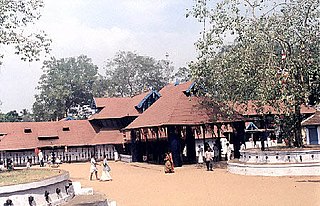
Sree Kurumba Bhagavati Temple is a Hindu temple at Kodungallur, Thrissur District, Kerala state, India. It is dedicated to the goddess Bhadrakali, a form of Mahakali or simply Durga or Aadi Parashakthi or Bhuvaneshwari or Kannagi worshipped and significantly revered in Kerala. The goddess is known also by the names "Sri Kurumba"". This temple is the head of 64 Bhadrakali temples in Kerala. This Mahakali temple is one of the oldest functioning temples in India. The goddess of the temple represents the goddess in her fierce ('ugra') form, facing North, featuring eight hands with various attributes. One is holding the head of the demon king Daruka, another a sickle-shaped sword, next an anklet, another a bell, among others.

Silambu, or Gaggara, is an anklet worn and used in a variety of contexts on the Indian subcontinent.

Sree Valayanad Devi Temple dedicated to Bhagavathy, is situated in Valayanad near Kozhikode in North Kerala, India.
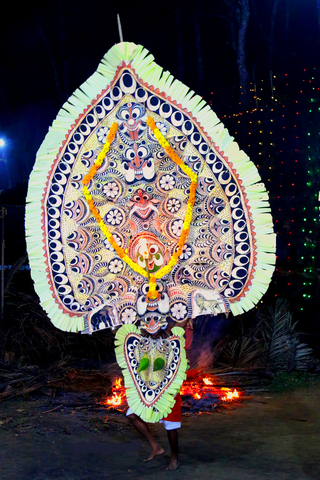
Padayani, also known Padeni, is a traditional folk dance and a ritual art from the central portion of the Indian state of Kerala. A ceremonial dance involving masks, it is an ancient ritual performed in Bhagavati temples. The dance is performed in honor of Bhadrakaali. Meaning, a 'row of warriors', Padayani is an art form that blends all music, dance, theatre, satire, facial masks, and paintings. It is part of worship of Bhadrakali and is staged in temples dedicated to the goddess from mid-December to mid-May. Padayani is unique to central Travancore, comprising the Pathanamthitta and Kottayam districts of Kerala. It is also performed in adjoining regions of Kollam, Alappuzha districts.

The MajorVellayani Devi Temple is a highly revered shrine in Kerala, India, dedicated to goddess Bhadrakali. The shrine is situated in Vellayani 1.5 km west of Vellayani junction, 12 km southeast of Thiruvananthapuram on the eastern bank of Vellayani Lake. The temple is under the management of Travancore Devaswom Board. The temple structure has a bronze roof with traditional art work and carries Dravidian architecture. The temple has eastern and northern towers called Gopurams with statues of different Gods sculptured in them. The Gopurams function as gateways through the walls that surround the temple complex.
Velichappadu in Malayalam translates as Revealer of Light, is the oracle or mediator between a deity and devotees at a Hindu Temple in Kerala. Prominent in Valluvanad, the Velichappadu, also known as Komaram in some parts, is an integral part of the rituals in a Bhagavathi temple. There are both male and female Velichappadu and often belong to a particular family. People, in Kerala and beyond, have enormous respect for these mediating oracles when they're in their trances and heed to their words.
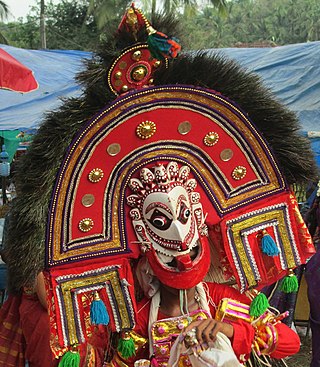
Poothamkali is folk art form in the state of Kerala, India. This art form uses various types of decorations in the costume. It is usually performs in the Bhagavathy temples of Malappuram district. It is based on the myth of Durga and her combat with Darika.
Malavazhiyattam also known as MalavayiyattamKariniliyattam or Cheruniliyattam is a ritualistic folk art of the Paraya community in Kerala, India. It is music and drama performed to please Malavazhi, a mother goddess worshiped by the Parayas and installed in their homes.
Ninabali is a ritualistic performing art form popular in Kannur, Kozhikode districts of northern Kerala, India. It is a folk art performed by the Malaya community. This art form, which is performed in homes as part of Hinuist exorcism ceremonies, depicts the battle between Bhadrakali and the asura Darika.

Chozhikali, also spelled as Chozhi Kali, is a folk dance popular in Central Kerala, India. There are two types of Chozhikali: Thiruvathirachozhi and Kudachozhi. It is performed by the Hindu community in Palakkad and Thrissur districts of Kerala.

Kaliyoottu also known as Kali natakam is a ritualistic performing art popular in Thiruvananthapuram Kollam districts of southern Kerala, India. It is a folk art related to the battle between Bhadrakali and the asura Darika.
















